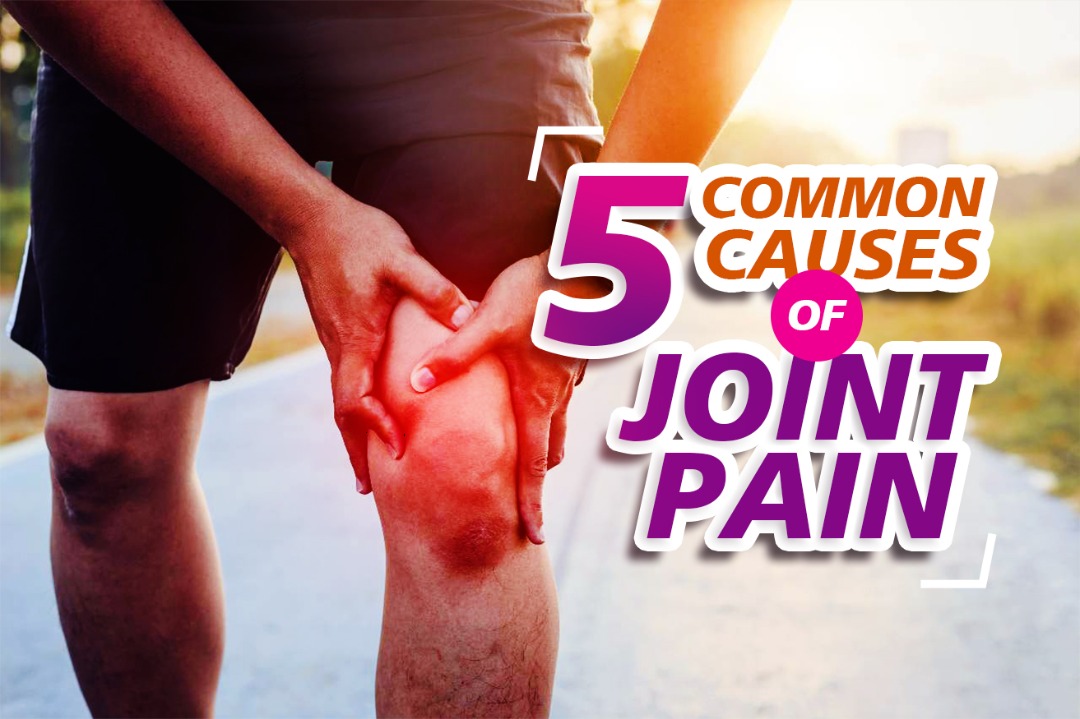Introduction
Joint pain is a common problem that affects people of all ages and can range from mild discomfort to severe pain. It can limit mobility and impact daily activities. There are many causes of joint pain, from injuries to underlying medical conditions. Understanding the common causes of joint pain is essential for proper diagnosis and treatment, which can help alleviate symptoms and improve quality of life.
Epidemiology of Joint Pain
Joint pain is a prevalent health issue affecting millions of people globally, regardless of age or gender. According to the Global Burden of Disease Study, musculoskeletal conditions, which include joint pain, are the second leading cause of disability worldwide.
Osteoarthritis (OA) is the most common cause of joint pain, particularly in older populations. Its prevalence increases significantly with age, affecting nearly 10% of men and 13% of women over the age of 60. In contrast, conditions such as rheumatoid arthritis (RA) and gout, while less common, also contribute to a significant number of joint pain cases. Rheumatoid arthritis affects approximately 1% of the global population, while gout affects about 3.9% of adults in the U.S.
Causes of Joint Pain
Joint pain can sneak up on anyone, regardless of age, activity level, or overall health. It’s not just a symptom of getting older—it’s a signal that something deeper is happening in your body.
1. Bad Posture: The Silent Culprit
We often think about posture in relation to back pain, but did you know that poor posture is one of the leading causes of joint pain? Bad posture misaligns your body’s joints—from your neck and shoulders to your hips, knees, and even feet. When your joints are out of alignment, the surrounding muscles overcompensate, which leads to inflammation. This inflammation can spread to nearby joints, triggering arthritis over time. Fixing your posture can prevent further damage, but chronic misalignment often leaves lasting pain.
2. Overuse of Joints
If you’ve ever pushed your body too hard at the gym or worked at a job that requires repetitive motions, you’ve likely experienced the pain of overused joints. Overuse is a common reason for joint pain, especially in the knees, elbows, and wrists. Chronic wear and tear erodes the cartilage that cushions your joints, leading to painful conditions like osteoarthritis. Additionally, autoimmune diseases such as rheumatoid arthritis, lupus, and scleroderma occur when the body’s immune system mistakenly attacks its own tissues, including the joints.
For those living with gout, joint pain is caused by a buildup of uric acid crystals in the joints. When these sharp crystals accumulate, they trigger intense inflammation, particularly in the big toe. Overuse combined with these underlying conditions creates a perfect storm for joint pain.
3. Injury or Trauma
Joint injuries are a direct and obvious cause of joint pain, but their long-term effects are often underestimated. Dislocations, fractures, and even minor sprains can alter the mechanics of a joint. Once this happens, you’re more likely to develop arthritis or other chronic joint conditions. Joint trauma damages not just the bones but also the cartilage, ligaments, and tendons that hold the joint together. Even after healing, an injured joint may never function as smoothly as it once did, leading to ongoing discomfort.
4. Inflammation
While inflammation is your body’s natural response to injury, chronic inflammation is one of the key causes of joint pain. Acute inflammation due to an injury usually resolves with time, but if the inflammation becomes chronic, it can damage the joint itself. This is especially true for conditions like rheumatoid arthritis, where the immune system attacks the lining of the joints, causing swelling, stiffness, and pain. Unlike an injury that heals over time, inflammatory arthritis often worsens, making early treatment critical to managing pain and preventing joint destruction.
5. Infection
Though less common, infections are a serious cause of joint pain that shouldn’t be ignored. A bone infection, or osteomyelitis, can cause severe joint pain and requires immediate medical attention. Osteomyelitis occurs when bacteria enter the bone through an open wound, surgery, or a severe break. Left untreated, these infections can spread, leading to further joint damage or even life-threatening complications. Joint pain caused by infection is often accompanied by fever, chills, and a general feeling of being unwell, signaling that it’s time to see a doctor immediately.
How to Manage Joint Pain
Managing joint pain involves a multi-faceted approach depending on the underlying cause, severity, and the patient’s overall health. Below are some of the most effective strategies for managing joint pain:
1. Medications
Medications are often the first line of treatment for managing joint pain, particularly in cases of inflammatory conditions like rheumatoid arthritis or osteoarthritis. These include:
- Nonsteroidal Anti-Inflammatory Drugs (NSAIDs): Commonly used to reduce pain and inflammation in conditions like osteoarthritis and rheumatoid arthritis. Examples include ibuprofen and naproxen.
- Corticosteroids: These powerful anti-inflammatory drugs can be administered orally or injected directly into the affected joint for more immediate relief.
- Disease-Modifying Antirheumatic Drugs (DMARDs): Used specifically for rheumatoid arthritis, DMARDs slow the progression of joint damage.
2. Physical Therapy
Physical therapy can help improve joint function and mobility. It focuses on strengthening the muscles around the joint, which helps reduce stress on the affected area. Techniques like stretching exercises, aquatic therapy, and resistance training are often employed.
3. Weight Management
Obesity is a major risk factor for joint pain, particularly in the knees and hips, where excess body weight increases stress on the joints. Weight loss can significantly reduce the symptoms of joint pain, particularly in cases of osteoarthritis.
4. Heat and Cold Therapy
Applying heat or cold to painful joints can help relieve symptoms. Cold therapy helps numb acute pain and reduce swelling, while heat therapy relaxes muscles and promotes blood flow, which can help alleviate chronic joint stiffness.
5. Assistive Devices
For severe joint pain or conditions like osteoarthritis, using assistive devices can ease the pressure on affected joints. Devices such as braces, canes, or shoe inserts provide support and improve mobility.
6. Lifestyle Changes and Exercise
Low-impact exercises like swimming, cycling, and walking help maintain joint flexibility without putting too much pressure on the joints. Yoga and tai chi are also effective in improving joint flexibility and reducing pain through gentle movement and stretching. Additionally, avoiding high-impact activities and practicing proper posture can help prevent further joint damage.
7. Surgery
For cases where conservative treatments do not alleviate the pain, surgical options may be considered. These include arthroscopy, joint replacement, or osteotomy. Joint replacement surgeries, particularly in the knees and hips, have become increasingly successful in restoring mobility and reducing pain.
8. Supplements
Taking Evergreen Vitamin D3 and Evergreen Bone Support contain the nutrients like Magnesium, Calcium, Vitamin D3 and other nutrients for strengthened bones.
Conclusion
Joint pain is a widespread issue affecting millions of people, stemming from various causes like osteoarthritis, injuries, infections, and autoimmune disorders. Understanding the common causes of joint pain is crucial for proper management and prevention. Early diagnosis and treatment can significantly improve quality of life, reducing discomfort and preventing further joint damage. Maintaining a healthy lifestyle, avoiding overuse of joints, and seeking medical advice when necessary are key steps in managing joint pain effectively.
FAQs
- What are the most common causes of joint pain?
The most common causes of joint pain include osteoarthritis, rheumatoid arthritis, injuries, gout, and bursitis.
- Can poor posture cause joint pain?
Yes, poor posture can lead to joint pain by placing excessive strain on muscles and joints, particularly in the spine, hips, and shoulders.
- How does osteoarthritis cause joint pain?
Osteoarthritis causes joint pain by wearing down the protective cartilage that cushions the bones, leading to friction and inflammation in the joints.
- Is joint pain always related to arthritis?
No, joint pain can also be caused by injuries, infections, overuse, or autoimmune disorders such as lupus and fibromyalgia.
- How can joint pain from injuries be managed?
Joint pain from injuries can often be managed with rest, physical therapy, anti-inflammatory medications, and in some cases, surgical intervention.
- Can gout affect any joint in the body?
While gout most commonly affects the big toe, it can also cause pain in other joints such as the ankles, knees, wrists, and elbows.
- Is there a cure for rheumatoid arthritis?
While there is no cure for rheumatoid arthritis, early diagnosis and treatment can help manage symptoms and slow down the progression of the disease.
- Can infections cause joint pain?
Yes, infections like septic arthritis can cause severe joint pain and inflammation and require immediate medical treatment to prevent joint damage.
- What lifestyle changes can help prevent joint pain?
Maintaining a healthy weight, exercising regularly, using proper posture, and avoiding repetitive strain on joints can help prevent joint pain.
- When should I see a doctor for joint pain?
You should see a doctor if your joint pain is severe, lasts for more than a few days, or is accompanied by swelling, redness, or fever.

















